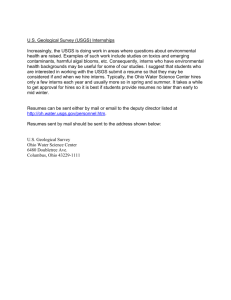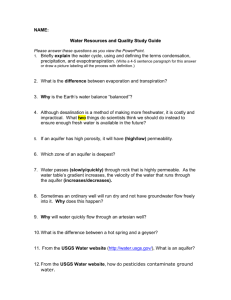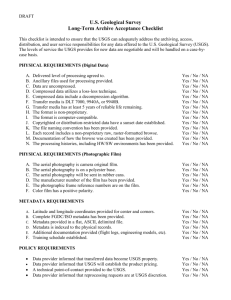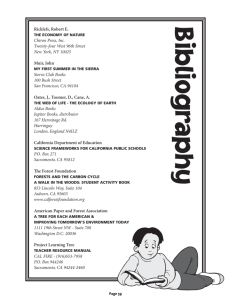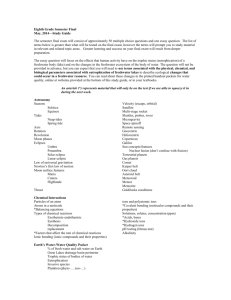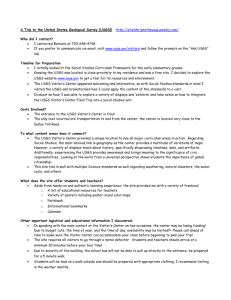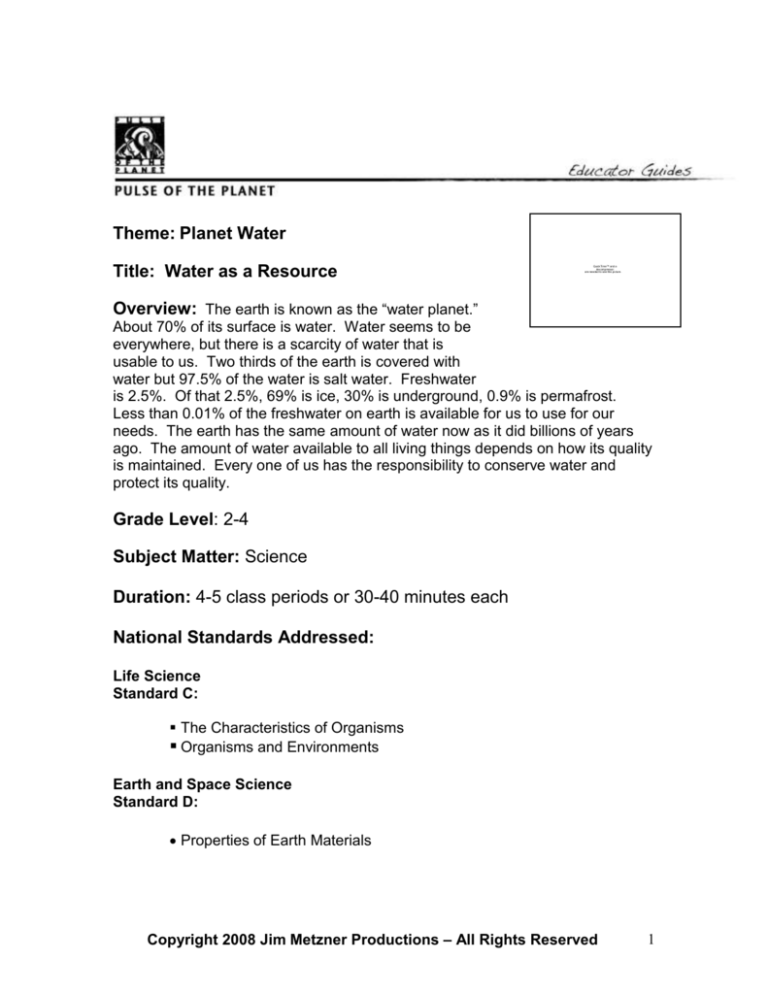
Theme: Planet Water
Title: Water as a Resource
QuickTime™ and a
decompressor
are needed to see this picture.
Overview: The earth is known as the “water planet.”
About 70% of its surface is water. Water seems to be
everywhere, but there is a scarcity of water that is
usable to us. Two thirds of the earth is covered with
water but 97.5% of the water is salt water. Freshwater
is 2.5%. Of that 2.5%, 69% is ice, 30% is underground, 0.9% is permafrost.
Less than 0.01% of the freshwater on earth is available for us to use for our
needs. The earth has the same amount of water now as it did billions of years
ago. The amount of water available to all living things depends on how its quality
is maintained. Every one of us has the responsibility to conserve water and
protect its quality.
Grade Level: 2-4
Subject Matter: Science
Duration: 4-5 class periods or 30-40 minutes each
National Standards Addressed:
Life Science
Standard C:
The Characteristics of Organisms
Organisms and Environments
Earth and Space Science
Standard D:
Properties of Earth Materials
Copyright 2008 Jim Metzner Productions – All Rights Reserved
1
Science in Personal and Social Perspectives
Standard F:
Types of Resources
Changes in Environments
Objectives:
Students will identify the many uses of water.
Students will discuss ways to reduce the amount of water they use each
day.
Students will identify ways water gets polluted.
Materials:
Computers with internet access
Clear jars, soil, sand, cheesecloth, rubber band
5 gallon container, tablespoon, 3 clear containers, eyedropper
Posterboard for each student and magazines
Procedure:
Part 1:
Review the term resource (a material found in nature that is used by living
things).
o Have students name resources.
o Today we will be learning about ‘water.’ Have students name things
we use water for.
Listen to POP #2057 Water Everywhere. Discuss with children the
amount of saltwater and freshwater on earth.
Use the following activity to help them visualize the small percentage of
freshwater on earth that is available for living things. (Activity 2, How Wet
is Our Planet?):
Kid’s Corner - The Groundwater Foundation
http://www.groundwater.org/kc/kc.html
Show students the 5 gallon container and ask them to predict how many
gallons of water they think their family uses each day. Have some
students share their predictions and reasons.
As a homework assignment, have the student, with an adult at home, use
the water calculator to determine the number of gallons used per day in
their household. Handout (How Much Water Does Your Family Use?)
provided for their prediction and actual number.
On this website go to Activity Center-Questionnaires:
Water Q & A – USGS:
http://ga.water.usgs.gov/edu/qahome.html
Copyright 2008 Jim Metzner Productions – All Rights Reserved
2
Part 2:
Discuss the results of the homework assignment (How Much Water Does
Your Family Use?)
o
Discuss some of their ideas to reduce the water usage in
their homes.
Listen to POP #387 Low Flush Toilets. Listen to the first 10 seconds only.
Ask the students what they think the sound is (toilet flushing). Listen to the
rest.
o
Ask the class what the largest indoor use of water is
(flushing the toilet).
o
Ask what they learned about the low flush toilet. (It uses 1.6
gallons of water to flush compared to a normal toilet that
uses 5 gallons of water per flush.)
Read the book The Magic School Bus at the Waterworks by Joanna Cole
and Bruce Degen.
Use the following website to find out more ways the students can
conserve water:
10 Easy Ways To Be Water Friendly – Play Pumps International
http://www.knowh2o.org/site/c.jgLLITOFKtF/b.3481793/k.2B3/10_Ways_to
_Save_Water.htm
Have students individually or with a partner design a water conservation
sign to encourage others to use less water. Display.
Part 3:
Water Pollution
Use the following video on water pollution as an introduction.
http://pbskids.org/eekoworld/index.html?load=air_water
Listen to POP #724 Surfrider. Ask students what it is about. (It is an
organization founded by surfers to reduce coastal water pollution.)
Ask when is the most bacteria found in the ocean and why. (Rain washes
harmful chemicals from the land into the ocean and other water bodies.)
In conclusion use the websites. (Beach Kids and What’s Wrong With This
Picture?):
http://www.epa.gov/kids/water.htm
Part 4:
As a class demonstration, do the Environment-Clean Water activity from
Gryphonhouse.com. (It is using sand to clean soil out of water.) Discuss
what they think about cleaning bacteria that they can’t see from the water.
http://www.gryphonhouse.com/activities/index.asp?CatID=8
Listen to POP #4247 Science Diary: Beach Sand. (It is about a Middle
School science fair project. The students are trying to filter bacteria from
water using sand.)
o Discuss what was learned about sand filtering bacteria out of
water.
Copyright 2008 Jim Metzner Productions – All Rights Reserved
3
Students will create a collage or collection of pictures that show the
different ways people use water. They also can include pictures of things
that need water to live.
o Share with the class and display.
As a culminating activity, students can view a water video and take the
water quiz at this website:
http://www.knowh2o.org/site/c.jgLLITOFKtF/b.3429435/k.BE42/Home.htm
Optional ideas:
Two lessons have good ideas to extend this unit, at the following websites:
“Water is Life, Water is Poetry Seminar” – WaterPartners International
(PDF):
http://www.water.org/FileUploads/WPElemCurric3_0.pdf
“World-Water Hero” – WaterPartners International (PDF):
http://www.water.org/FileUploads/WPElemCurric5_0.pdf
Scroll Down for more…
Copyright 2008 Jim Metzner Productions – All Rights Reserved
4
Handouts:
How Much Water Does Your Family Use?
1. I think my family uses _______ gallons of water per
day. There are _______ people that live in my house.
2. Use the Activity Center Questionnaire at this
website to determine your family’s water usage per
day.
Water Q & A – USGS
http://ga.water.usgs.gov/edu/mqanda.html
3. I learned that my family uses about _____ gallons of
water per day.
4. Here are some ideas to reduce the amount of water
my family uses.
Copyright 2008 Jim Metzner Productions – All Rights Reserved
5
NAME: ________________________________
Additional Resources
Water Resources
Name: Lake Surface
URL: http://en.wikipedia.org/wiki/Image:Water_surface_lake.jpg
Caption: The surface of a freshwater lake in daylight.
Credit: Manage891a3 / Wikipedia
Name: Groundwater Flow
URL: http://en.wikipedia.org/wiki/Water_resources
Caption: A cross sectional diagram showing qualitative flow times for various
pathways through a typical aquifer system, from USGS circular 1139.
Credit: USGS
Name: Iceberg 10
URL: http://en.wikipedia.org/wiki/Image:Carlb-newfoundland-iceberg-2002.jpg
Caption: An iceberg as seen from Newfoundland.
Credit: Carl B. / Wikipedia
Name: Wetland 3
URL: http://en.wikipedia.org/wiki/Image:Sinclair_Wetlands.jpg
Caption: This is a panorama of Sinclair Wetlands near Dunedin, in New Zealand.
Credit: Donovan Govan
Name: Water Pollution
URL: http://en.wikipedia.org/wiki/Image:Water_pollution.jpg
Caption: Water pollution is one of the main concerns of the world today. The
governments of many countries have striven to find solutions to reduce this
problem. Many pollutants threaten water supplies, but the most widespread,
especially in underdeveloped countries, is the discharge of raw sewage into
natural waters.
Credit: EPA
Name: 2025 Projected Water Scarcity
URL: http://en.wikipedia.org/wiki/Image:Iwimi.jpg
Copyright 2008 Jim Metzner Productions – All Rights Reserved
6
Caption: As the picture shows, in 2025, water shortages will be more prevalent
among poorer countries where resources are limited and population growth is
rapid, such as the Middle East, Africa, and parts of Asia. By 2025, large urban
and peri-urban areas will require new infrastructure to provide safe water and
adequate sanitation. This suggests growing conflicts with agricultural water
users, who currently consume the majority of the water used by humans.
Credit: International Water Management Institute (2000)
Name: Aquifer Diagram
URL: http://water.usgs.gov/ogw/gwrp/saltwater/salt.html
Caption: Ground-water flow patterns and the zone of dispersion in an idealized,
homogeneous coastal aquifer.
Credit: USGS
Name: Rain!
URL: http://en.wikipedia.org/wiki/Image:TorrentialRainBallina.jpg
Caption: A torrential downpour in Ballina, Australia.
Credit: Nerge
Name: River
URL: http://en.wikipedia.org/wiki/Image:MariaValeriaBridge.jpg
Caption: This bridge across the Danube River links Hungary with Slovakia.
Credit: Alan Ford
Name: Ocean Wave
URL: http://en.wikipedia.org/wiki/Image:Cornwall_Wave.jpg
Caption: An ocean surface wave crashing into rocks.
Credit: Earth Network Editor
Web Links
Water Resources – American Museum of Natural History
http://www.amnh.org/exhibitions/water/?section=waterresources
Freshwater Society
http://www.freshwater.org/
Water Facts - Water Partners International
http://water.org/waterpartners.aspx?pgID=916
Water Q & A – USGS
http://ga.water.usgs.gov/edu/mqanda.html
Water Use in the U.S. – USGS
http://ga.water.usgs.gov/edu/wateruse.html
Copyright 2008 Jim Metzner Productions – All Rights Reserved
7
What is the Water Cycle? – USGS
http://ga.water.usgs.gov/edu/watercyclesummary.html
Groundwater Information Pages – USGS
http://water.usgs.gov/ogw/
Aquifer Basics – USGS
http://capp.water.usgs.gov/aquiferBasics/index.html
Kid’s Corner - The Groundwater Foundation
http://www.groundwater.org/kc/kc.html
Exploring Estuaries – EPA
http://www.epa.gov/owow/estuaries/kids/index.htm
The Water Cycle Kids Page – Southwest Florida Water Management District
http://www.swfwmd.state.fl.us/education/kids/watercycle.php
What is Groundwater? – The Groundwater Foundation
http://www.groundwater.org/kc/whatis.html
World Water Crisis – World Water Council
http://www.worldwatercouncil.org/index.php?id=25
Human Appropriation of the World’s Water Supply (>2006)) – University of
Michigan
http://www.globalchange.umich.edu/globalchange2/current/lectures/freshwater_s
upply/freshwater.html
Water at Glance – Water World Council
http://www.worldwatercouncil.org/index.php?id=5
Clean Water – Life Depends On It! – Environment Canada
http://www.ec.gc.ca/water/en/info/pubs/FS/e_FSA3.htm
Issues: Water: Natural Resources Defense Council
http://www.nrdc.org/water/default.asp
Global Water Challenge
http://www.globalwaterchallenge.org/home/home.php
Audio
“Water Policy Around the World” – NPR
Copyright 2008 Jim Metzner Productions – All Rights Reserved
8
http://www.npr.org/templates/story/story.php?storyId=6261527
Programming on Water (various) – Science Friday / NPR
http://www.sciencefriday.com/program/archives/200803211
Video
Water Resources Videos (various) – Play Pumps International
http://www.knowh2o.org/site/c.jgLLITOFKtF/b.3454013/k.B849/Watch.htm
Animation / Graphics
The New York City Water Story (scroll down) – AMNH
http://www.amnh.org/exhibitions/water/?section=waterresources#
Interactive Water Cycle (scroll down) - Environmental Kids Club / EPA
http://www.epa.gov/kids/water.htm
Wastewater Sewage in Your Face! (interactive games, audio, video) – City of
San Diego
http://www.sandiego.gov/mwwd/kids/index.shtml
H2o University – San Diego Water System
http://www.saws.org/education/h2o_university/index.cfm?CFID=32923&CFTOKE
N=c46b3d2b515e5745-4880D5D2-1143-D7A1-069E74F93D543771
Water Education Foundation
http://www.watereducation.org/Default.asp?
Wet in the City – Council for Environmental Education
http://www.wetcity.org/
Articles
“All About: Water and Health” – CNN.com
http://edition.cnn.com/2007/WORLD/asiapcf/12/17/eco.about.water/
“Water: Under Pressure” – Nature.com
http://www.nature.com/news/specials/water/index.html
Just For Kids
Copyright 2008 Jim Metzner Productions – All Rights Reserved
9
10 Ways Kids Can Be Water Friendly – Play Pumps International
http://www.knowh2o.org/site/c.jgLLITOFKtF/b.3481793/k.2B3/10_Ways_to_Save
_Water.htm
Water – Environmental Kids Club / EPA
http://www.epa.gov/kids/water.htm
Drinking Water and Ground Water Kid’s Stuff – EPA
http://www.epa.gov/OGWDW/kids/
Water Wonders: Environmental Education for Kids – Wisconsin Dept. of Natural
Resources
http://www.dnr.state.wi.us/org/caer/ce/eek/earth/groundwater/index.htm
The Story of Drinking Water – American Water Works Association
http://www.drinktap.org/kidsdnn/Portals/5/story_of_water/html/story.htm
Water Kids - Water Education Foundation
http://www.watereducation.org/doc.asp?id=1022
Other
Global Water Supply School Curriculum – Water Partners International
http://water.org/waterpartners.aspx?pgID=920
Take the Know H2o Water Quiz – Play Pumps International
http://www.knowh2o.org/site/c.jgLLITOFKtF/b.3470659/
Sample H2o Lesson Plans – Play Pumps International
http://www.knowh2o.org/site/c.jgLLITOFKtF/b.3454019/k.B76D/Water_Lesson_P
lans_from_the_National_Youth_Leadership_Council.htm
How Big is Your Water Footprint? (calculator) – Partners for the Saskatchewan
River Basin
http://www.saskriverbasin.ca/watchdog/footprint.htm
H2o Calculator – H2o Conserve / John Hopkins University
http://h2oconserve.org/home.php?pd=index
Water Education Coloring Book (PDF) – USGS
http://water.usgs.gov/H2O_ColoringBook.pdf
Water Education Posters (scroll down for water use) – USGS
http://capp.water.usgs.gov/aquiferBasics/index.html
Copyright 2008 Jim Metzner Productions – All Rights Reserved
10
Special thanks to the following scientists for their help with this project:
Pulse of the Planet Programs: #116 “Lake Baikal: Oldest in the World”
Ken Nealson
Professor of Earth Sciences and Biological Sciences
Wringley Institute for Environmental Studies
University of Southern California
Pulse of the Planet Programs: #387 “Low Flush Toilets”
Robert Kourik
Author, “Grey water Use in the Landscape”
Pulse of the Planet Programs: #724 “Surfrider: Testing the Waters”
Robert Caughlin
The Surfrider Foundation
*Information current at the time of interview
Pulse of the Planet Programs: #2057 “Fresh Water”
Melanie Stiassny
Axelrod Research Curator
Department of Ichthyology
American Museum of Natural History
Pulse of the Planet Programs: #4247 “Science Diary: Beach Sand – Sand”
Adina Paytan
Associate Research Professor
Institute of Marine Sciences
University of California at Santa Cruz
Header Image
Name: Lake Surface
Credit: Manage891a3
Copyright 2008 Jim Metzner Productions – All Rights Reserved
11

